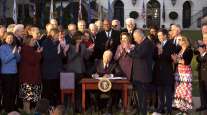Senior Reporter
IIJA’s Implementation Gained Momentum in 2022

[Stay on top of transportation news: Get TTNews in your inbox.]
President Joe Biden during his State of the Union Address to Congress this year proclaimed that the United States was embarking on an “infrastructure decade,” setting the tone for the administration’s efforts to implement the bipartisan $1 trillion infrastructure law.
Enacted in the fall of 2021, the Infrastructure Investment and Jobs Act, or IIJA, advanced rollout of myriad projects across the transportation landscape for most of this year. More than $200 billion has been allocated for state agencies managing programs aimed at revitalizing or modernizing freight and commuter corridors, according to the White House. These programs include rebuilding roads and bridges, investing in public transit and boosting Amtrak’s rural service. The White House described the bill as “the largest long-term investment in our infrastructure and competitiveness in nearly a century.”
Other policy goals of the legislation include build-out of a network of electric vehicle chargers, and trucking workforce initiatives focused on training younger drivers and expanding diversity.
“We’re doing everything that we can to improve the careers in the professions that power our supply chain,” Transportation Secretary Pete Buttigieg said during a Dec. 6 visit to UPS’ Worldport in Kentucky. “We’re building new truck parking, so that drivers can get safe rest. We’ve launched the Women in Trucking Advisory Board, because we can’t leave half of America’s talent on the table and miss out on a generation of great drivers because women aren’t supported in the career.”

Transportation Secretary Pete Buttigieg at the UPS Worldport hub in Louisville, Ky. (Secretary Buttigieg via Twitter)
To promote the representation of women in transportation, the IIJA established the Women of Trucking Advisory Board. The Federal Motor Carrier Safety Administration coordinates its functions to ensure the board serves as a platform for “reviewing opportunities to enhance safety, training, mentorship and education for women in the trucking industry.” The agency also intends for the board to identify “opportunities to expand roles for women and increase the number of women” in the industry.
Endorsement of the board came from stakeholders such as American Trucking Associations. In July, ATA launched its own initiative, Women In Motion, to amplify women’s contributions to trucking and to recognize companies that adopt and pursue best hiring practices.
The legislation also included the Safe Driver Apprenticeship Pilot. The program is designed to train drivers under the age of 21 to operate commercial vehicles interstate. The goal is to offer young people a career path, and also tackle workforce concerns plaguing the industry. ATA has determined the industry is short approximately 78,000 drivers, down slightly from last year’s estimate of 80,000.
The law’s focus on supply chain connectivity has been a central component for stakeholders, especially as the effects of pandemic-related delays have lingered. And supply chain bottlenecks hindering the movement of freight were high on policymakers’ radars. This year, the White House launched the Freight Logistics Optimization Works, or FLOW. “The FLOW initiative builds on previous successes of the Biden-Harris supply chain disruptions task force to ensure cargo is getting from ship to shelf,” the White House said.
“Most Americans would assume there’s more data sharing than there is,” Buttigieg said in October at the ATA Management Conference and Exhibition, emphasizing that access to such data might improve dialogue among stakeholders. “That’s going to allow us to see things in the system that we just can’t see right now, in terms of where the backups are going to be.”
For Buttigieg, supply chain connectivity improvements would ideally complement safety initiatives. The U.S. Department of Transportation updated guidance to promote safety throughout mobility corridors. A key factor for federal officials was recent data estimating nearly 43,000 traffic fatalities in 2021, marking a 10.5% increase from the prior year.

Blumenthal (left) and Markey.
On Capitol Hill, Democratic Sens. Ed Markey of Massachusetts and Richard Blumenthal of Connecticut pressed DOT to facilitate the implementation of safety enhancements. Per the senators and some of their colleagues, provisions in the IIJA linked to the National Highway Traffic Safety Administration merited closer attention. These included recall completion rates, seat back safety standards, automatic vehicle shut-offs, crash avoidance technologies, driver monitoring systems and potential updates to hood and bumper standards.
“When issuing new safety measures, regulators have too often crawled through yellow lights or stalled at red lights. By passing a historic, bipartisan infrastructure law, Congress gave NHTSA the green light to put its pedal to the metal to reduce motor vehicle fatalities,” the senators told the department.
A big THANK YOU to @SenLummis & @SenMarkKelly for their strong leadership on the issue of #truckparking. As Congress looks for ways to strengthen the supply chain, this bill is low-hanging fruit and would boost highway safety for all motorists.
: — American Trucking (@TRUCKINGdotORG) December 1, 2022
Congress also set its sights on passing truck parking legislation. In December, a bill meant to improve such access for truck drivers nationwide was introduced in the Senate. The Truck Parking Safety Improvement Act, sponsored by Sens. Cynthia Lummis (R-Wyo.) and Mark Kelly (D-Ariz.), aims to increase parking capacity as well as improve parking areas.
“Without safe truck parking, truckers spend an unnecessary amount of time searching for a place to park,” Lummis said, “putting truckers and Wyoming drivers at greater risk for accidents. This is easily solvable, and I am thankful to Sen. Kelly for joining me in finding a common-sense solution.”
Over the summer, the House Transportation and Infrastructure Committee approved a similar bill sponsored by Rep. Mike Bost (R-Ill.). The House version would provide transportation agencies funding for building or expanding such areas for commercial vehicles. To assist with parking needs, DOT awarded grants for parking projects in Florida and Tennessee.
These efforts are welcomed by trucking as insufficient access to parking remains a concern for the industry. Truck parking ranked third on the American Transportation Research Institute’s “Critical Issues in the Trucking Industry” unveiled in 2022.

DeFazio
In December, Congress also assisted in averting a nationwide railroad strike that would have cost the economy an estimated $2 billion daily. Specifically, Congress cleared for Biden the provisions negotiated in a tentative agreement reached in September by the Presidential Emergency Board, as the threat of a strike had caused a frenzy among government agencies and the private sector. ATA was among the groups calling on Congress to intervene in the matter. “Further delays only result in more uncertainty and inflationary pressure at a time when the economy is straining under the weight of both,” ATA President Chris Spear said. “Trucking is not alone in calling on Congress to act immediately.”
Prior to the vote on the railroad labor issue, Rep. Peter DeFazio (D-Ore.), chairman of the Transportation and Infrastructure Committee, had expressed support for workers involved in the negotiations. Most of the unions argued for additional quality-of-life improvements.
Want more news? Listen to today's daily briefing above or go here for more info
“We’re here today because we recognize what makes this country run — its frontline workers. Without them, just under one third of our country’s freight would sit idle,” DeFazio said. “We know the current conditions cannot continue — because without improvements to their ability to reliably spend time with family, be sick without punishment, schedule a doctor appointment or plan a vacation, railroad workers will continue to leave this industry. And when the best of our essential workers leave, we all suffer.”
DeFazio, a member of the chamber since the mid-’80s, did not seek re-election for another term. His colleagues and industry leaders touted DeFazio’s contributions related to infrastructure funding. As a result of the midterm elections, Republicans will control the House committees beginning Jan. 3, 2023.
“Republicans are ready to deliver,” Rep. Kevin McCarthy (R-Calif.), the front-runner for the speakership, said in November. “It’s a new direction toward an economy that is strong. Where you can fill up your tank, feed your family. Where your paychecks grow, and not shrink.”




